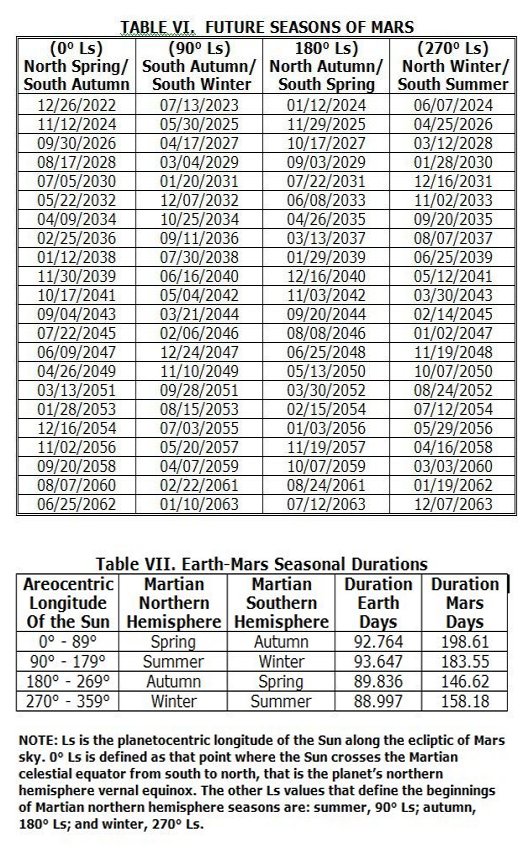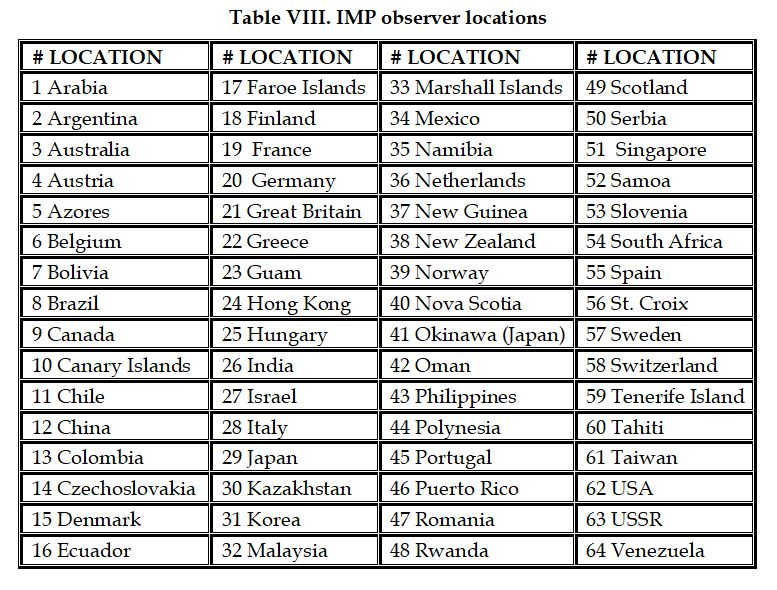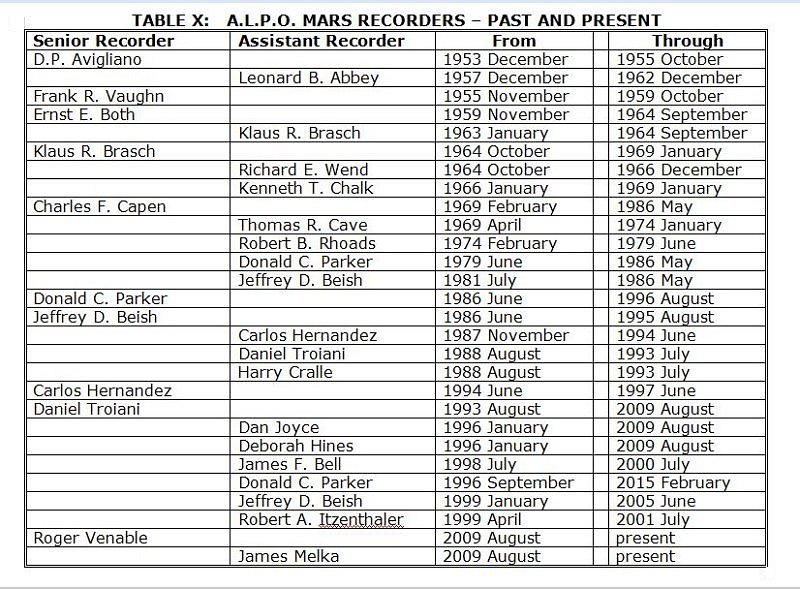General Information - Observing Mars
Jeff Beish, A.L.P.O. Mars
Section (10-Aug-2024)
INTRODUCTION
Mars appears more Earth like to us than most of the other planets because we can observe its surface, atmospheric clouds and hazes, and its brilliant white polar caps. The latter are composed of frozen carbon dioxide (CO2) and underlying water ice (H2O), and wax and wane during the Martian year. These aspects, along with the changing seasons and the possibility of life, have made Mars one of the most studied planets in our solar system. Mars offers both casual and serious observers many challenges and delights, as well as providing astronomers a laboratory to study the atmosphere and surface of another planet. Some Martian features even appear to shift position around the surface over extended periods of time. Because Mars has no oceans its charted land area is about equal to that of our own planet because Mars has no oceans.The orbits of Earth and Mars are elliptical, Mars having a highly eccentric orbit while that of Earth is more nearly circular. The distance between the Earth and Mars varies from 248,700,000 miles, when Mars is in conjunction with the Sun and may approach within 34,650,000 miles during Perihelic apparitions, or as far away as 63,000,000 miles during Aphelic apparitions. A brief description of planetary motions in orbit around the Sun can be found in Planetary Aspects.
MOTION OF MARS IN OUR SKY
As a general rule, an "apparition" begins when a planet emerges from the glare of the Sun shortly after conjunction. It will not be safe to observe Mars until it is at least 12 degrees away from the glare of the Sun. From the time we first see Mars rising early in the morning sky until western quadrature (90° west of Earth) and the phase or terminator will be increase. After quadrature the phase will decrease until it nearly disappears around opposition. For detailed definitions and graphics for the motion of Mars in our sky see this excellent web site: Elongations and Configurations.
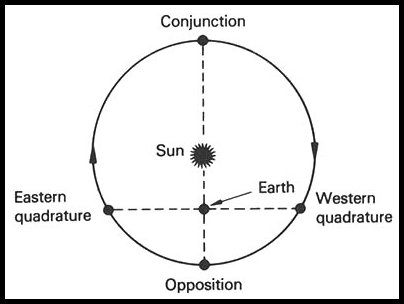
Figure 1. A heliographic chart of the orbits of Mars and the Earth showing the relative positions of both planets. Quadrature is when Mars is directly east or west of Earth as shown.
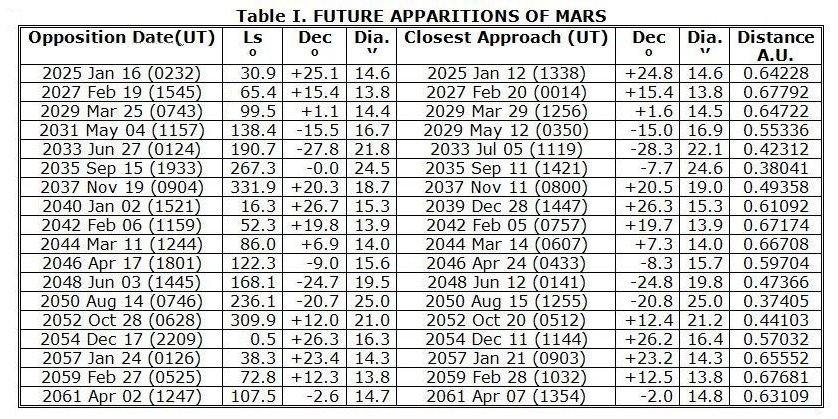
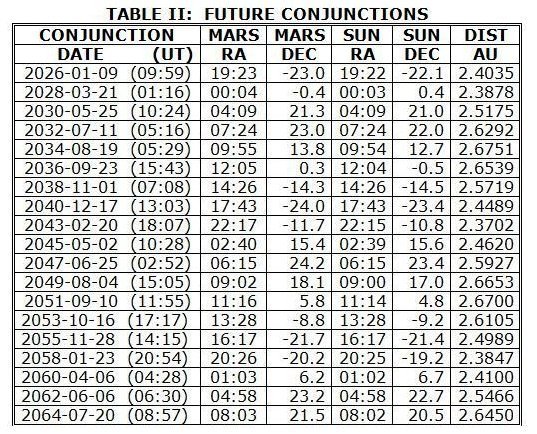
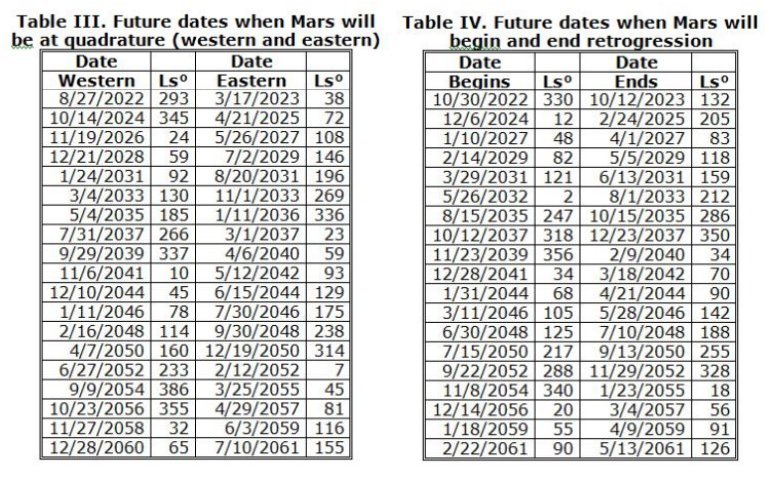
Tables presented in the pre-apparition reports are based on computer programs written and compiled by the author using equations found in the book Astronomical Algorithms by Jean Meeus [Meeus,1991]. The location of features on Mars that are referred to in this general articles can be found on the following Mars Charts:
1954 ALPO
Mars Section Mars Chart: Mars_1954_ALPO_Map.jpg
New ALPO Mars Section
Mars Chart: Mars_Map_Venable-Melka.jpg
ALPO Mars Section Mars
Chart: Alpomarsmap.jpg
Ebasawa Mars Chart: Ebasawamars.jpg
DAYS AND SEASONS ON MARS
The Martian solar day, or "sol", is about 40 minutes longer than a day on Earth. Consequently Mars only rotates through 350° of longitude in 24 hours. As a result, astronomers on Earth observing a particular Martian surface feature one night, will see that same feature positioned 10° further west on Mars (or closer to its morning limb) the next night at the same civil time. Mars and Earth have four comparable seasons because their axes of rotation (obliquity relative to orbital plane) are both tilted at about the same angle to their respective orbital planes, 25.1894°+/-0.0001° for Mars and 23.5° for Earth [Kieffer et al, 1992] [Yoder and Standish, 1997].
NOTE: Prior to Marinier 9 this value was 25° +/- 0.1° [Michaux, 1972]. In describing Martian seasons, scientists use the term "Ls" which stands for the Areocentric longitude of the Sun along Mars’ ecliptic. The zero point, 0° Ls, is set at the Martian vernal equinox when the Sun, moving northward, appears to cross the celestial equator in Mars’ sky. Thus, 90° Ls is the northern hemisphere summer solstice, 180° the autumnal equinox, etc. The seasons are, of course, reversed for the southern hemisphere.
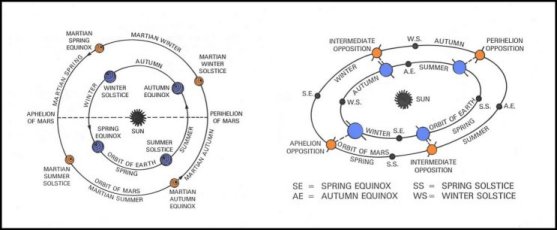
Figure 2. Graphs showing the relative positions of Earth and Mars in their respective orbits around the Sun. Left: show the seasons for each planet. Right: Shows the relative posits of each planet as it relates to cardinal points in each orbit.
The Martian year is 1.88 tropical Earth years consisting of 668.59 Martian days (sols) or 686.98 Earthy days and its mean synodic period 779.94 mean days. We find the synodic period from the mathematical expression:
1/s = 1/Pe - 1/Pm, where Pe = 365.26 days and Pm = 686.98 days.
The axis of Mars does not point toward Polaris, our North Star, but is displaced about 40° towards Alpha Cygni. Because of this celestial displacement, the Martian seasons are 85° out of phase with respect to terrestrial seasons, or about one season earlier than ours. Consequently, when you observe Mars next spring and summer, it will be winter and spring, respectively, in the Martian southern hemisphere.
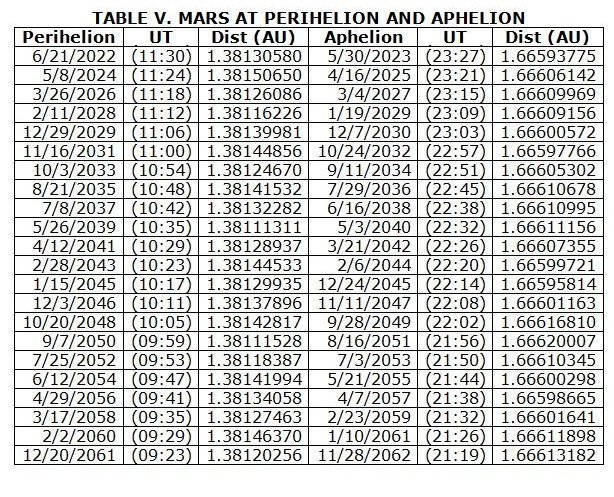
THE INTERNATIONAL MARS PATROL
The International Mars Patrol (I.M.P.) is a cooperative
program by planetary observers located around the Earth making it possible for
a 24- hour surveillance of all Martian longitudes. Observers were located in 64
foreign countries and
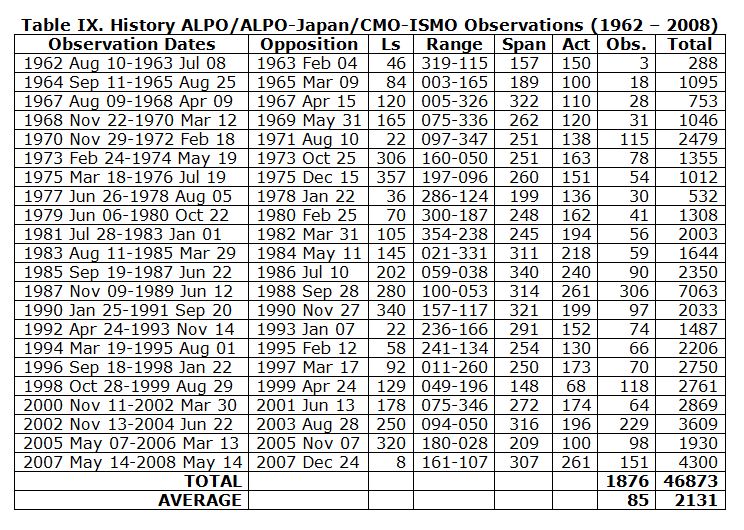

NOTE: Modern technology, like CCD and webcam digital cameras, has greatly increased the efficiency even of small telescopes that in the past were considered less than optimal for serious planetary observing. Over the past decade an increased systematic use of color filters and modern CCD technology has led to renewal of interest in observing Mars. Many thousands of additional observations could be added to the table above; however, at this time the totals for the 2009 apparitions and beyond have not been made available.
During the 1980’s and early 1990’s the I.M.P. participated in professional activities providing observers for Lowell Observatory’s International Planetary Patrol and provided quality photographs of Mars to the United States Geological Survey for creating maps of albedo features of the Red Planet. However, due to Federal budget cuts these programs have been severely limited to a narrow scope and amateur participation has all by disappeared.
The I.M.P. coordinates and instructs the cooperating observers in using similar visual, photographic (film and electronic), photometric, and micrometric techniques employing color filters and standard methods for reporting their observations. The chronological filing of this large quantity of data requires the observation information obtained for each night Universal Date be recorded on one or two standard observing report forms!
Each apparition the A.L.P.O. Mars Section receives thousands
of individual observations consisting of visual disk drawings made with the aid
of color filters, black-&-white and color photographs, intensity
estimates of light and dark albedo features, color
contrast estimates, and micrometer measurements of polar caps, cloud
boundaries, and variable surface features during the 10 to 12 month observing
period. The chronological filing of this large quantity of data requires the
observation information obtained for each night Universal Date be recorded on
one or two standard observing report forms
It is with this regard that the A.L.P.O. Mars Coordinators
have prepared a simple, efficient and standard Mars observing Report Form. This
Standard Form, or its format, can be used for reporting all types of
observations such as; micrometry, transit timings, intensity estimates, etc.
Photographs may also be attached to the top or back of the form and the
relevant information blanks to be filled in at the telescope. Planetary aspects
blanks can be filled in at other times than while observing [Capen et al,
1981].
INTERNET LINKS
The ALPO web page: http://alpo-astronomy.org/
The ALPO-Japan web page: http://alpo-j.asahikawa-med.ac.jp/Latest/Mars.htm
The Mars Observer’s Café web page: index.html
Classical Martian Surface Feature Names and Location: names.htm
It is with this regard that the A.L.P.O. Mars Coordinators
have prepared a simple, efficient and standard Mars observing Report Form. This
Standard Form, or its format, can be used for reporting all types of
observations such as; micrometry, transit timings, intensity estimates, etc.
Photographs may also be attached to the top or back of the form and the
relevant information blanks to be filled in at the telescope. Planetary aspects
blanks can be filled in at other times than while observing [Capen et al,
1981].
REFERENCES
Capen, C.F., and Parker, D.C. (1981). "What is New on Mars - Martian
1979-1980 Apparition Report II, Journal of the Association of Lunar and
Planetary Observers (J.A.L.P.O.), Vol. 29, Nos. 1-2
Kieffer, H.H.,
B. M. Jakosky, C.W. Snyder, and M.S. Matthews,
Editors (1992), Chapter 9, "Long-Term Orbital and Spin Dynamics," Mars,
University of Arizona Press, pp.304-305
Meeus, Jean, Astronomical
Algorithms, Willmann-Bell, L.C. 91-23501
(ISBN 0 943396-35-2, 1st edition, 1991.
Michaux, C. M.
and R.L. Newburn, Jr., (1972), Mars Scientific
Model, JPL Document 606-1, March 1, Sections 1.1, "Rotational
Elements," pp. 10.
Michaux, C. M.
and R.L. Newburn, Jr., (1972), Mars Scientific
Model, JPL Document 606-1, March 1, Sections 4.2, "Seasonal
Activity," pp. 27.
Yoder, C. F. JPL and E. M. Standish, JPL, (1997),
"Martian precession and rotation from Viking lander
range data," JOURNAL OF GEOPHYSICAL RESEARCH, VOL. 102, NO. E2, PP. 4065-4080, 1997. http://www.agu.org/journals/ABS/1997/96JE03642.shtml
